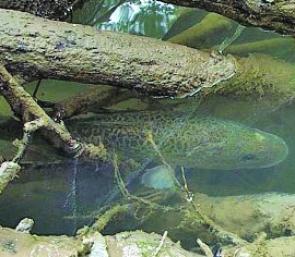Recreational freshwater fishing is a major beneficiary of the Murray Darling Basin Authority’s Native Fish Strategy. A rejuvenated fishery provides recreational freshwater fishers with enhanced opportunities to pursue their passions.
The Native Fish Strategy has been implemented to restore native fish communities in the Basin to 60% of pre European-settlement population over the next 50 years. This is a significant target, especially when 90% of native fish populations have been lost. A main focus of the Native Fish Strategy is to established as a Basin-wide program to reverse this loss, improving the health of our waterways, and helping to bring back native fish.
Community aspect is a very important part of the strategy, as well as the longterm commitment. The community surrounding these waterways will always be there and therefore need to have a sense of ownership of the waterways and all they encompass, and we also need to acknowledge that rehabilitating our rivers will take time. Government support is also very important to help guide community involvement and implement river health activities across the Basin.
To help meet these driving actions, simple onground works can be undertaken by the general community including planting native trees, excluding stock access to waterways, fishing responsibly, and raising awareness amongst other groups. Other larger scale projects are also being undertaken through the NFS including establishing demonstration reaches, improving fish passage, managing alien fish and undertaking important research.
The Basin is home to more than 2 million people, who rely upon the river systems for their livelihood, including agriculture, recreation, tourism and employment. Over the years this has placed a lot of pressure on the waterways of the Basin and the animals and plants that depend on them. This is most evident in our native fish species, which are great indicators of river health.
Some of the threatened fish of the Basin include freshwater catfish, which have declined in population as a result of changes to flow regimes, pressure from alien species and reduction in water quality including sedimentation and salinity; and Murray cod, which have suffered decline in numbers as a result of overfishing and removal of habitat. Murray cod is nationally recognised as ‘threatened.’
There are numerous threats to native fish across the Basin, with some of the major ones including habitat condition, in stream structures and alien fish.
Habitat condition is one of the most significant impacts on native fish, with 97% of waterways modified in some way, which can include loss of riparian vegetations, reduced water quality and the removal of snags. This can lead to loss of shade, loss of food supply (over 40% of a fish’s diet can come from trees), increased sedimentation, loss of buffer zone for nutrients, and loss of natural regeneration.
Instream structures include dams, weirs and road crossings. Estimations indicate that there over 20,000 of these structures across the Basin. These structures, whilst needed to service our needs, can alter flow regimes that our native fish have evolved with by using the flow in rivers as a cue to migrate, stop fish from moving upstream (an important part of a native fish’s breeding cycle), and also lead to cold water pollution when water gets released from the bottom of dams (which can have impacts on native fish downstream).
The final factor is the increase of alien fish. There are now 12 alien fish species resident in the Basin, including European carp, goldfish and gambusia, which are found in every river of the Basin. Alien fish have a significant impact on native fish by dominating in the competition for food, space and shelter. Introduced species also spread disease, prey on native fish and disrupt aquatic and riparian environments.
This is particularly so with carp, which make up more than 60% of fish biomass across the Basin. Carp alter the natural environment during their feeding when they stir up sediment and reduce habitat quality. They dominate waterways due to their prolific breeding, with a 6kg female producing up to 1.5 million eggs.
Gambusia also have a significant impact on native fish, and although they are a small fish they are very aggressive, fin nipping small bodied native species, as well as eating native fish eggs.
Demonstration reaches are another important aspect of the Strategy. A demonstration reach is intended to show by example, the need for river rehabilitation to address the full range of issues threatening native fish communities. It demonstrates the benefits achieved by integrated on-ground activities over a large stretch of river. The successful rehabilitation of a reach improves community awareness and support, provides visible examples, focuses the attention of funding agencies and boosts scientific knowledge of rivers and fish.
There are currently seven demonstration reaches established across the Basin, including Condamine (Qld), Namoi (NSW), Upper Murrumbidgee (NSW), Brewarrina to Bourke (NSW), Ovens River (Vic), Goulburn River (Vic) and Katfish (SA). Hundreds of different types of community engagement activities have also been conducted, including 10 ever popular carp muster events.
Activities that may be undertaken as part of demonstration reaches include native revegetation (especially on riverbanks), riparian land management through fencing and providing off-stream water, placing snags back into the water (especially important for Murray cod, with over 80% of them found within 1m of a snag), weed management using best management practice, and raising community awareness with fishing events, monitoring programs and education activities.
Two key messages of the strategy are that NFS is a co-ordinated longterm commitment to bringing native fish back to the basin, and that recreational fishers are key to achieving the goals of the NFS.
The above text has been extracted from an address prepared by Tony Townsend and Greg Ringwood, both NFS co-ordinators, and presented by Tony at a forum held recently at Glenlyon Dam. Photos are courtesy of NSW Fisheries.
Reads: 7110
One of the biggest problems facing Murray cod is the deteriorating condition of their natural habitat.

Murray cod hook ups are becoming rarer; this species is officially classed as ‘threatened’.




